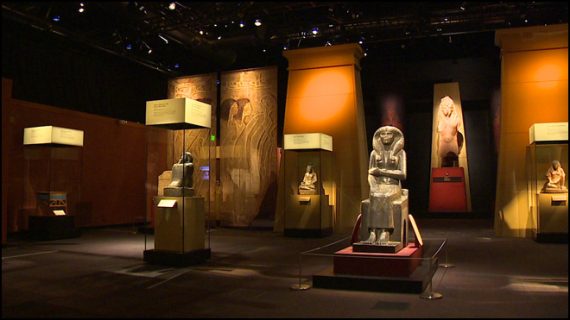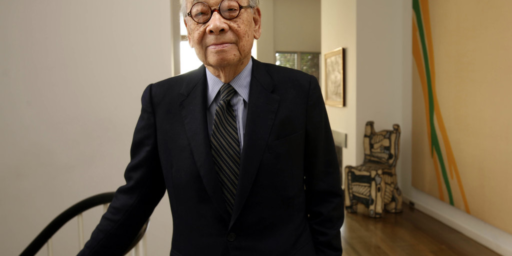The Case Against Repatriating Museum Artifacts
Who should own antiquity?
James Cuno, President and CEO of the J. Paul Getty Trust, previews his new book Museums Matter: In Praise of the Encyclopedic Museum and Who Owns Antiquity? for Foreign Affairs magazine. Most of the article is behind a paywall and I have access because I’m a subscriber, so I’ll be judicious in my excerpting here. The core of the setup is this:
In 2011, the German government agreed to return to Turkey a 3,000-year-old sphinx that German archaeologists had excavated from central Anatolia in the early twentieth century. Afterward, the Turkish minister of culture, Ertugrul Gunay, declared that “each and every antiquity in any part of the world should eventually go back to its homeland.”
Such claims on the national identity of antiquities are at the root of many states’ cultural property laws, which in the last few decades have been used by governments to reclaim objects from museums and other collections abroad. Despite UNESCO’s declaration that “no culture is a hermetically sealed entity,” governments are increasingly making claims of ownership of cultural property on the basis of self-proclaimed and fixed state-based identities. Many use ancient cultural objects to affirm continuity with a glorious and powerful past as a way of burnishing their modern political image — Egypt with the Pharaonic era, Iran with ancient Persia, Italy with the Roman Empire. These arguments amount to protectionist claims on culture. Rather than acknowledge that culture is in a state of constant flux, modern governments present it as standing still, in order to use cultural objects to promote their own states’ national identities.
In the battle over cultural heritage, repatriation claims based strictly on national origin are more than just denials of cultural exchange: they are also arguments against the promise of encyclopedic museums — a category that includes the Metropolitan Museum of Art, in New York; the British Museum, in London; and the Louvre, in Paris. By presenting the artifacts of one time and one culture next to those of other times and cultures, encyclopedic museums encourage curiosity about the world and its many peoples. They also promote a cosmopolitan worldview, as opposed to a nationalist concept of cultural identity. In an era of globalization that is nonetheless marked by resurgent nationalism and sectarianism, antiquities and their history should not be used to stoke such narrow identities. Instead, they should express the guiding principles of the world’s great museums: pluralism, diversity, and the idea that culture shouldn’t stop at borders — and nor, for that matter, should the cosmopolitan ideals represented by encyclopedic museums. Rather than acquiesce to frivolous, if stubborn, calls for repatriation, often accompanied by threats of cultural embargoes, encyclopedic museums should encourage the development of mutually beneficial relationships with museums everywhere in the world that share their cosmopolitan vision. Cultural property should be recognized for what it is: the legacy of humankind and not of the modern nation-state, subject to the political agenda of its current ruling elite.
My longstanding sympathies on this issue are with Cuno. The natural extension of Gunay’s argument is that the regimes that currently govern a given territory somehow have exclusive rights to any object that has ever been on that plot of land, may do whatever it is they wish to with it, and that the only way anyone should be allowed to ever see said object is to visit that country. This, despite the fact that most of the great antiquities in places like the Louvre or MMOA were discovered by Western archaeologists in digs financed by Western sources and have been preserved because Westerners cared enough to do so. Indeed, current regimes often intentionally destroy ancient artifacts:
A national government or state-backed entity can even declare a preceding state’s or regime’s self-proclaimed national cultural property idolatrous and destroy it, and there is nothing any other country or any international agency can do to stop it. In 2001, UNESCO tried in vain to prevent the Taliban from demolishing the Bamiyan Buddhas, two monumental sixth-century statues carved into a cliff in central Afghanistan. Not even a meeting between UN Secretary-General Kofi Annan and representatives of the Taliban leader could spare the statues.
Since that notorious attack, threats to the world’s cultural heritage have only become more common. UNESCO lists sites where what it calls “emergency actions” to protect cultural heritage are needed; the list currently includes places in Egypt, Haiti, Iraq, Libya, Mali, and Syria where cultural property is threatened by either armed conflict or, in the case of Haiti, natural disaster. These actions, led by UNESCO, assess and document the extent and severity of the damage to, for example, the Roman-era ruins of the ancient desert city of Palmyra, in Syria, and Aleppo’s Old City, both designated as UNESCO World Heritage sites and both damaged in 2012 in fighting between the Syrian army and rebels in the ongoing Syrian civil war, and Egypt’s Museum of Islamic Art, in Cairo, which was damaged in a bombing claimed by Islamist militants in January.
Cuno and I agree that stolen artifacts are a different matter, and that the presumption should be for their repatriation. But it’s not at all obvious why the current government in Egypt, for example, should enjoy custody of every artifact of the Pharaonic period.







Here’s my question about this: why, necessarily, should a recovered object go back to the country that currently occupies the land where it was found, rather than to the nation that’s the inheritor of the culture that created that object?
In the above case, for example, there was no “Turkey” and there were no Turks 3,000 years ago. The ancestors of the Turks were a small tribe of nomads in eastern Asia who didn’t arrive in present-day Turkey until about 1071 AD and Anatolia up to that time was occupied in large part by Greeks. If a sphinx was sculpted 3,000 years ago, it was probably created by Greek, Assyrian, or Egyptian speaking peoples, so why shouldn’t it go to Greece or Iraq or Egypt?
And that’s just one example. Here are some others: if an Ottoman manuscript is found in Athens, shouldn’t it go back to Turkey than to Greece? Similarly, if a statue scuplted by a Greek-speaking Roman citizen in 100 AD in Ephesus, Anatolia is discovered, isn’t it far more of a Greek and/or Italian piece of cultural patrimony than it is of the Turks? Etc. etc. etc.
If you want to put the argument “ad absurdum”, a German painting, confiscated by the Nazis, could be turned over to heirs in NY, and immediately send back to Germany because of “cultural heritage”.
This is not just an international issue. I remember a big hoopla months ago about repatriating a bunch of Hopi masks. Some kind donor bought them at auction and returned them to Hopi officials on what was probably those masks’ last day on Earth.
Me, I’m not sure some overarching principle can be declared on this. I’m not comfortable saying that only the Egyptians have claim to artifacts from the Pharaonic era. But I also think that people deserve to have some claim over their own history.
It should be case by case, tilted towards respectful preservation.
@Mu:
Well, not quite, not at all, actually, because in that case the painting would have actual legal owners. You could no more confiscate the painting for “cultural heritage” than you could confiscate my Biedemeier chairs or Bauhaus desk. We’re discussing cases where the objects have no known legal owner. If there’s an owner, that trumps all.
Return the slab, or suffer my wrath…
Oh, never mind.
@James Pearce:
True, I agree, but then we get to the question of which people and whose history? The peoples and nations of the past are not all the same as those of the present. Is a piece of Roman pottery found in England a part of Italy’s history or of England’s? Does it belong to Italy, the cultural ancestor of the Roman Empire, or to England, the geographical successor state (even though the Anglo-Saxon ancestors of most present-day English didn’t show up until after the Romans left?). Or what if the pottery was cast by a Greek slave — should it really go back to Greece?
It is not possible to have a civilized society without property rights that the state defends. I can’t be eternally vigilant and fighting people who find my stuff and declare “finders, keepers.” My property rights do not erode with time. Therefore, the idea that someone can claim something and take it to a museum in another country is not comfortable for me.
Property rights vary from place to place for example in the American west property owners typically do not own rivers below the high water mark running across their land while in Virginia there are deeded crown rights to some rivers. A nation can define property rights for antiquities as national rather than private. I am not comfortable with the idea that a foreign national does not have to abide by the host nation’s rules.
The idea that museum serve an educational function is right, but observance of property rights won’t interfere. Loans are common as are traveling exhibits. I saw King Tut without traveling to Egypt.
I’ll argue for the country or instiution which has the will and resources to best preserve the ancient artifact. Hopefully, that will the country that has the best claim to be a successor to the culture that produced the artifact.
Here, I’m comfortable with England getting the nod.
@Rafer Janders:
Exactly. This is why I think it’s hard to come up with some kind of principle on this. Maybe “Finders Keepers” is the way to go, but that obviously has it’s own issues.
I read a book by Craig Childs called just that recently. Very interesting.
@stonetools:
Curious as to why?
Or what if we reverse it — what if it’s an 11th century Danish helmet worn by a Viking mercenary fighting in Sicily, buried there, and now dug up? Does it stay in Italy where found, or does it belong to Denmark where it was made?
@Slugger: No one is arguing that it’s simply finder’s keepers. In many of these cases, though, whoever sponsored the dig that produced the find did so under agreement with the extant government, usually either for some percentage of the loot, “all the gold and silver found,” or some other arrangement. Why should those agreements be invalidated post hoc?
@James Pearce:
Yeah, “Finders Keepers” will often result in countries which have no actual connection to the cultural patrimony of the object becoming the custodian at the expense of a country with an actual and identifiable connections (as for example in my Turkey / Greece examples above, where much of present-day Turkey was actually part of Greece and/or the Byzantine Empire for thousands of years, and where there’s as good or better arguments for Greek / Byzantine cultural treasures discovered there being given to Greece rather than being kept by the Turks).
@Slugger:
I have some sympathy for this, but in many cases we’re talking about artifacts that predate even the concept of property rights.
For instance, who owns the ruined buildings in Chaco Canyon? Right now, the federal government owns it. Before that, it was a private citizen*, and prior to that….no one “owned” it for centuries. The people who built it literally abandoned the canyon, the region, and their culture. If you ask their ancestors, the aforementioned Hopi and others, what to do with the buildings, they’ll probably say re-bury them and let it be, to quit digging around and putting things in museums. Close the park, close the gift shop, and tell all the park rangers to leave.
Should they have the “right” to do that with something that is only tenuously their “property?”
* The way he “managed” the site actually inspired the Antiquities Act of 1904. Same guy, named Richard Wetherill, also “discovered” Mesa Verde.
Culture is beyond current national boundaries. Modern day Turkey has nothing to do with the glory of the Ottoman empire, modern day Greece has little relationship to the glory of Ancient Greece. These artifacts belong to all members of western civilization.
A couple of thoughts.
Repatriation doesn’t eliminate the possibility of loans. If I ran the Egyptian Museum, I would make sure that there were plenty of artifacts around the world that demonstrated my culture’s accomplishments. I’d want there to be places like the MMOA where people could go and be overwhelmed by the exhibits. I’d also set up exchanges, making sure that the people of my country got to see Rembrandts and Monets in exchange for a couple of minor-league mummies. There’s no reason that even full, 100% repatriation would necessarily restrict the availability of works.
Second, repatriation can be reasonable. As a hard and fast rule, it’d be nuts, as some of the examples above demonstrate. But there are different levels of claims. A gold statue found in the water off the coast of Haiti might belong in Spain, the owners of the vessel when it sank. It might belong to the American team of divers who found it, according to salvage laws. The Haitians might have a claim to it as an example of the country’s legacy of piracy. It probably belongs in Mexico, where it was crafted from Mexican gold. This gets to be like a lawsuit assigning liabilities for damages – they’re never going to be assigned in a perfectly fair way, especially since we’re dealing with discrete items. We can move in the direction of repatriation prudently. Prudence is the balance between all the different rules and absurdums.
As for the Roman pottery in England, it probably doesn’t belong to “England” so much as the person who owned the land where it was discovered, or the family in whose possession the pottery has been. English pottery in Rome would be different – it may have been bought by Romans, but it’s very possible that it had been taken.
Personally, if I were English, I could understand having some pride in the Roman pottery discovered in England. If I were Roman, I wouldn’t feel anything toward English pottery that someone had bought or stolen 1800 years earlier. But again, the foundation of the claim matters. Is the item valuable because it demonstrates the level of workmanship of the era and people, or because of its beauty, or because it tells us something about the culture?
@James Pearce:
Which runs smack into another political problem: there’s an ongoing debate as to what extent the Anaasází were related to the current Hopi or Pueblo cultures. Hopi and Pueblo creation myths are based on them originating in North America rather than migrating from Asia, so they naturally claim that the Anaasází were their ancestors. Many other scientist argue that the Anaasází was completely unrelated and were replaced by the ancestors of the modern tribes during later migrations.
When their is a disagreement over who is the actual ancestor of a culture, who wins? Particularly when one side wants to use their “cultural claims” over such ruins to deliberately impede scientific study?
@Stormy Dragon: I say, if a Hopi or a Pueblo has the guts to sit down and eat someone, that’s proof enough for me.
I have thought a lot about this issue but will try to be brief.
One of the great things about artifacts is their ability to speak across cultures. They are like material ambassadors, bringing forms and values across the globe, making peoples vividly aware of one another. I do adore the British Museum but am not invested in the encyclopedic museum per se, like Jim Cuno is. What I favor is the presence of artifacts from one culture within the spaces and cultures of another. I think it would be a tragedy if all objects were repatriated, as so that they spoke only of a local past to local people. Sharing objects is a key thing that has made us global citizens. Perhaps we need to try to be better global citizens, but letting each culture monopolize it’s material past is not the way.
Instead, I suggest that taker cultures sent some of their own treasures to compensate other places. Britain has a lot of paintings by Turner. They should send a dozen to Greece and keep the Elgin marbles. I know it will never happen but it should.
Forgive all the typos, am writing on my iPad…
Loans are not an adequate substitute for permanent placement for several reasons. First, it is really bad for many artworks to travel much. Once Britain sends its Turners to Greece they need to stay there. Conservators at the Tate Britain, after they have finished weeping, can set the demands for a display environment that will best conserve the paintings. Greek conservators can do the same for the marbles.
Second, loan exhibitions are a glamorous display of exoticism that is quite different from having representatives of other cultures dwelling among you as it were. If the Elgin Marbles had spent three months in England they would not be an integral part of two cultures as, I feel, they are now. This is a crucial factor.
@Stormy Dragon:
That is the question, isn’t it?
It leads one to be tempted to support leaving this up to the territorial government. But then we’re back to the Bamyan Buddhas…..
I think where a primary country that wants its artifacts back is in a situation to preserve and protect said artifacts that efforts should be made to return them. I don’t think this should be absolute-I think its okay to say “Your country is currently incapable of preserving his artifact due to X, Y and Z therefore it is staying in France (or wherever).”
I would rather we focus on the preservation and study of the artifacts than who should own them when the provenance is well established. Stolen artifacts are a different matter.
@Just Me:
Can Japan demand my parents return their Honda CRV? How old does it have to be before they can?
Considering from what I saw of the Cairo Museum I don’t think they’re really up to guarding and preserving millions of dollars of Pharonic antiquities.
If I were them, I would have secretly swapped everything out for copies and stored the originals in a vault somewhere. Heck, there are certainly good enough counterfeiters running around.
@grumpy realist: Actually this is very realistic. I heard a talk some time ago (maybe 1980s) by some archaeologists working in Egypt. They said that they were digging up Coptic textiles, measuring and photographing them, and then reburying them because the mud preserved them better than they would be preserved in the Cairo museum.
But preservation shouldn’t be the criterion for sending all the artifacts back to a single nation. It’s just a terrible, weirdly jingoistic idea, like the current state owns everything anybody on this soil ever made forever. I disagree so completely with that. States play politics with heritage — you should hear the “Flemish” government now madly trying to claim most of Belgium’s heritage as really belonging to the Flems and not the rest of Belgium. Next thing you know they will be wanting the Van Eycks back from Paris and New York because, Flemishness. It happens over and over.
Artifacts, except in cases of documented looting (and with a certain statute of limitations), should stay where they are. OK, if a colonial power was involved in “purchases” I’d be willing to make some exceptions. But in general, the movement of objects should be accepted and even encouraged. I love how the Louvre is sending a boatload of its paintings to a specially-built museum Dubai (I think). Excellent! They should stay there forever. And think how much more of China’s heritage would have been destroyed in the Cultural Revolution had it not been in western museums.
OK, I will shut up now. This is one of my obsessions.
One thing we’re not directly discussing is the role of private collectors. Some of the most important collections in the world are private. Some of those are on loan to public museums, some are in private museums, and some are on private display. The other issue we’re sort of not addressing is the line between works of art and items of historical value. The more I think about this, the more I lean against any sort of hard-and-fast rules.